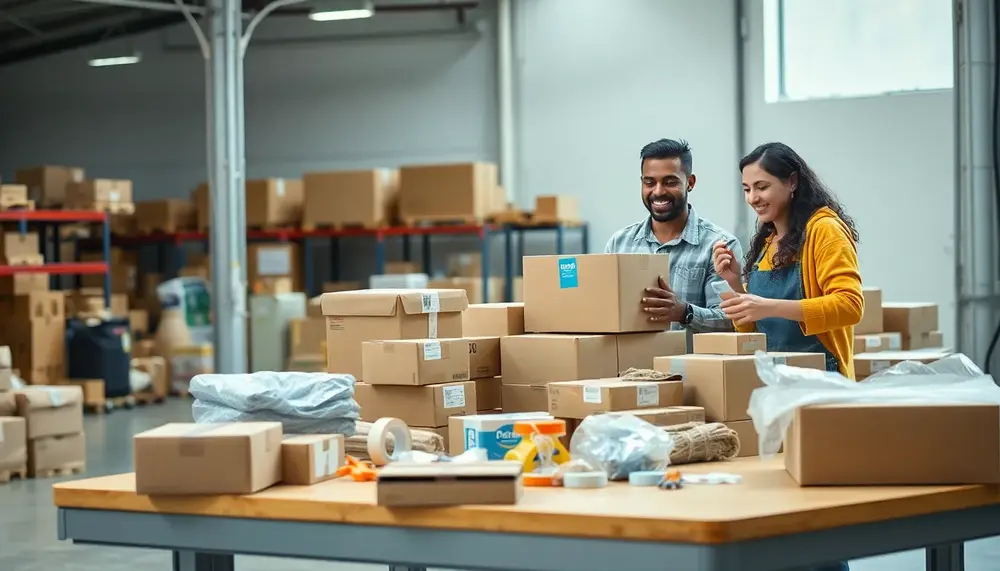Table of Contents:
Key Benefits of a Heavy Duty Packing Table for Streamlined Packaging Operations
Key Benefits of a Heavy Duty Packing Table for Streamlined Packaging Operations
Investing in a heavy duty packing table transforms packaging operations from a daily struggle into a seamless, almost rhythmic process. One of the most immediate advantages is the remarkable stability under load—these tables simply don’t wobble, even when stacked with bulky cartons or awkwardly shaped parcels. That means fewer accidents, less wasted time, and a noticeable drop in damaged goods. But there’s more beneath the surface.
- Consistent Workflow, Even at Peak Times: When order volumes spike, flimsy tables buckle under pressure. A heavy duty model absorbs the chaos, allowing teams to work at full tilt without stopping to fix or replace equipment.
- Integrated Storage and Tool Access: Many models come with built-in shelves, hooks, or even power outlets. This isn’t just a nice-to-have; it means tape, labels, and scanners are always within arm’s reach, eliminating frantic searches and keeping hands moving where they matter most.
- Ergonomic Customization: Adjustable height and modular add-ons let users tailor the table to their exact workflow. The result? Less strain, fewer repetitive injuries, and happier, more productive staff.
- Clean, Professional Work Environment: Let’s be honest—clutter slows everything down. Heavy duty packing tables offer ample surface area and smart organization options, so every item has its place. The whole operation just looks and feels more professional.
- Long-Term Cost Savings: While the upfront investment is higher, these tables rarely need replacing. Fewer breakdowns and less downtime mean the table pays for itself, often sooner than expected.
In short, a heavy duty packing table isn’t just another piece of furniture—it’s the backbone of a packaging operation that runs like clockwork, even when the pressure’s on.
How Robust Construction Ensures Workflow Reliability During High-Volume Packing
How Robust Construction Ensures Workflow Reliability During High-Volume Packing
When packaging demand skyrockets, the last thing anyone needs is a table that can’t keep up. Robust construction isn’t just about brute strength—it’s about unwavering dependability shift after shift. Imagine steel frames that shrug off impacts, or reinforced joints that don’t creak under sudden weight changes. That’s the real game-changer during peak periods.
- Vibration Resistance: High-volume packing means constant movement—boxes sliding, tape dispensers snapping, scales shifting. A well-built table absorbs these vibrations, keeping sensitive equipment stable and reducing the risk of costly packing errors.
- Durability Against Wear: Surfaces made from stainless steel or HDPE resist scratches, dents, and chemical spills. This ensures the table remains functional and presentable, even after thousands of cycles.
- Consistent Load Support: Reinforced legs and crossbars distribute weight evenly, preventing sagging or warping. This means every square inch of the work surface can be used with confidence, no matter how hectic things get.
- Low Maintenance Downtime: With fewer parts that loosen or fail, robust tables rarely require unscheduled repairs. That’s less disruption and more uninterrupted workflow—exactly what’s needed when deadlines are tight.
In essence, robust construction acts as a silent partner in high-volume packing, quietly ensuring that every process runs as planned, no matter how intense the workload becomes.
Pros and Cons of Using a Heavy Duty Packing Table in Packaging Operations
| Pros | Cons |
|---|---|
| Exceptional stability under load, preventing accidents and damage | Higher initial investment compared to standard tables |
| Integrated storage and tool access for improved workflow efficiency | May require more space due to robust construction |
| Ergonomic customization to reduce strain and repetitive injuries | Heavier weight can make repositioning difficult without casters |
| Durable materials and construction, offering long-term cost savings | Potential over-specification for small-scale operations |
| Enhances professional appearance and organization of the workspace | May require assembly or special installation |
| Supports high-volume, high-speed packing without workflow interruptions | Selection requires careful consideration of material and load needs |
Real-Life Example: Solving Bottlenecks With the Right Packing Table
Real-Life Example: Solving Bottlenecks With the Right Packing Table
Consider a mid-sized e-commerce warehouse that struggled every holiday season. Orders piled up, but the real headache was the bottleneck at the packing station. Workers found themselves waiting for space, shuffling between crowded surfaces, and sometimes even assembling boxes on the floor. Productivity nosedived, and mistakes crept in as the pressure mounted.
After a careful workflow analysis, management invested in a set of heavy duty packing tables with modular extensions and dedicated zones for different packing tasks. Each table featured a separate area for box assembly, a central section for order consolidation, and a clean-off zone for final inspection. The difference was immediate and striking:
- Task Segmentation: By assigning each step its own space, workers no longer tripped over each other or mixed up orders. Everything flowed in a logical sequence.
- Faster Throughput: With enough room for multiple packers, the team processed nearly 40% more orders per hour during peak times.
- Error Reduction: Clear separation between packing and labeling minimized shipping mistakes, cutting returns by almost half.
- Morale Boost: The team reported less stress and fatigue, since they weren’t scrambling for workspace or improvising with makeshift surfaces.
Bottom line: the right packing table didn’t just clear a physical bottleneck—it transformed the entire operation, making high-pressure periods manageable and even, dare we say, a little bit enjoyable.
Key Features That Optimize the Packing Process and Increase Efficiency
Key Features That Optimize the Packing Process and Increase Efficiency
Smart design elements can make a world of difference when it comes to packing speed and accuracy. Some heavy duty packing tables are equipped with integrated measuring guides, so workers can size up boxes and materials in a snap—no more hunting for rulers or tape measures. This little touch alone shaves seconds off every order, which adds up fast over a busy shift.
- Adjustable Shelving: Moveable shelves let teams customize storage for packing materials, reducing time spent searching for supplies and keeping the workspace tidy.
- Built-in Cutting Surfaces: Some tables include self-healing mats or dedicated cutting zones, making it safer and quicker to prep packaging without damaging the main worktop.
- Label Dispensers and Roll Holders: Integrated holders for tape, labels, and bubble wrap keep everything within arm’s reach, so the flow never stalls for a missing tool.
- Anti-Fatigue Mats or Footrests: Ergonomic add-ons like these help workers stay comfortable during long shifts, which translates to fewer mistakes and higher sustained productivity.
- Lighting Attachments: Direct task lighting ensures every detail is visible, even in dim corners of a warehouse, minimizing errors and eye strain.
Each of these features is a force multiplier—small tweaks that, together, create a packing station where efficiency isn’t just possible, it’s inevitable.
Choosing the Best Material and Load Capacity for Your Application
Choosing the Best Material and Load Capacity for Your Application
Matching your packing table’s material and load capacity to your specific workflow isn’t just a technicality—it’s the linchpin for long-term efficiency and safety. Different industries and environments call for different builds, and the wrong choice can lead to frustrating breakdowns or even safety hazards.
- Rubberwood: Ideal for light to moderate packing needs in clean, dry environments. Its smooth surface is gentle on delicate items, but it’s not suited for heavy impacts or exposure to moisture.
- Carbon Steel: The go-to for high-load, industrial settings. It resists bending under weight and shrugs off knocks, making it perfect for warehouses with bulky shipments. However, it may require a protective coating in humid areas to prevent rust.
- Stainless Steel: Best for food, pharmaceutical, or cleanroom applications. It’s corrosion-resistant, easy to sanitize, and handles both weight and harsh cleaning agents without flinching.
- HDPE (High-Density Polyethylene): Lightweight, chemical-resistant, and immune to most spills. A solid pick for labs or areas where corrosive substances are handled, though not as strong as steel for heavy loads.
As for load capacity, always factor in the heaviest combined weight your workflow might demand—not just the average. A table rated for 500 lbs+ can handle most high-volume e-commerce operations, while lighter-duty models might suffice for boutique or office-based packing. Overestimating here is far safer than the alternative.
In short, the right combination of material and load rating isn’t about overkill—it’s about peace of mind and a workflow that never hits a snag.
User Experiences: What High Ratings Reveal About Packing Table Performance
User Experiences: What High Ratings Reveal About Packing Table Performance
Consistently high user ratings for heavy duty packing tables aren’t just a fluke—they point to specific, real-world advantages that matter in daily operations. Reviews frequently highlight how these tables stand up to constant use, with many users noting that even after months of heavy workloads, the tables show little to no wear. That kind of durability inspires confidence, especially in environments where equipment failure simply isn’t an option.
- Assembly Simplicity: Users often praise the straightforward setup process. Many report that clear instructions and pre-drilled holes make assembly quick, reducing downtime when a new table is needed fast.
- Versatility in Layout: High ratings are common for tables that adapt easily to different workflows. Owners appreciate when a table can be reconfigured or accessorized as needs change, rather than becoming obsolete with new processes.
- Stability Under Pressure: Multiple reviews mention that the tables remain rock-solid, even when loaded with heavy items or subjected to repeated movement. This stability translates to fewer workplace accidents and less frustration.
- Customer Support: Another trend among top-rated models is responsive, helpful customer service. Users value quick solutions to issues like missing parts or questions about customization, which helps maintain productivity.
Ultimately, high ratings reveal that a great packing table isn’t just about specs—it’s about reliability, adaptability, and support that makes a real difference on the warehouse floor.
Practical Considerations for Selecting Your Heavy Duty Packing Table
Practical Considerations for Selecting Your Heavy Duty Packing Table
When it comes to choosing the right heavy duty packing table, there are a few practical factors that often get overlooked but can make or break your daily workflow. For starters, consider the available floor space and how the table will fit into your current packing area. Tables with compact footprints or foldable designs are a lifesaver in tight quarters, while larger models may suit expansive warehouse layouts.
- Mobility Needs: If your workflow requires frequent reconfiguration, opt for tables with lockable casters. This flexibility is invaluable for adapting to seasonal changes or shifting team sizes.
- Power Accessibility: For operations relying on electronic devices—scanners, label printers, or laptops—tables with integrated power outlets or cable management features keep cords organized and reduce trip hazards.
- Compliance and Safety: In regulated industries, ensure the table meets relevant standards for hygiene, fire resistance, or static dissipation. This can prevent costly compliance issues down the line.
- Future-Proofing: Look for modular designs that allow for add-ons or reconfiguration as your business grows. Investing in adaptability now can save significant costs and headaches later.
Taking the time to weigh these details ensures your packing table isn’t just a short-term fix, but a long-term asset that evolves with your operation.
Conclusion: Elevating Your Packaging Workflow With the Right Packing Table
Conclusion: Elevating Your Packaging Workflow With the Right Packing Table
Adopting a heavy duty packing table does more than just streamline tasks—it sets the stage for future growth and innovation. With the right table, teams can implement new packaging technologies or processes without the need for costly infrastructure changes. This adaptability opens doors to automation, specialized packing lines, or even eco-friendly initiatives that require unique materials or equipment setups.
Additionally, the right table can serve as a benchmark for operational standards. When you invest in quality, it signals a commitment to efficiency and professionalism that can ripple through the entire organization. Staff training becomes easier, as clear, well-designed workstations reduce onboarding time and help maintain consistency across shifts and locations.
Finally, a thoughtfully chosen packing table can support data-driven improvements. Surfaces designed for integration with tracking systems or digital tools make it possible to monitor productivity, identify bottlenecks, and fine-tune workflows in real time—giving your business a competitive edge that’s hard to match.
FAQ: Choosing and Using Heavy Duty Packing Tables Effectively
What advantages does a heavy duty packing table offer compared to standard tables?
Heavy duty packing tables provide exceptional stability, higher load capacity, and improved durability over standard tables. They’re designed to withstand repeated, demanding use, supporting smooth, high-volume workflows without the risk of wobbling, sagging, or damage.
Which materials are best for heavy duty packing tables?
Popular materials for heavy duty packing tables include carbon steel, stainless steel, and high-density polyethylene (HDPE). Steel options provide excellent strength and industrial robustness, while stainless steel is ideal for hygienic environments. HDPE offers chemical resistance and is lightweight, though less sturdy than metal for very heavy loads.
What features improve workflow efficiency in packing tables?
Key features include adjustable shelving, integrated power outlets, mobility options like lockable casters, modular extensions, and accessory holders for tape, labels, or tools. Ergonomic adjustability also helps reduce worker fatigue and error rates.
How do user reviews help when selecting a packing table?
User reviews highlight real-world experiences with assembly, stability under load, customer service, and adaptability. High ratings often indicate durability, ease of setup, and efficient design—helping buyers avoid common issues and choose models that are proven in similar environments.
What should be considered before purchasing a heavy duty packing table?
Consider the expected workload, space constraints, need for mobility or power features, and material compatibility with your environment. Also factor in compliance requirements and the possibility of future workflow changes—modular, flexible tables often provide the best long-term value.






